The expansive landscapes of Arizona, from its sun-kissed deserts to its whispering pine forests, serve as a home to an array of intriguing wildlife. Among these, owls hold a special place, their silent wings painting the dusk and dawn with an air of enchantment. From the star-studded night skies of Sedona to the cactus-dotted horizons of Tucson, these nocturnal raptors form an integral part of the state’s rich ecological tapestry.
With an astonishing thirteen species along with many other birds of prey gracing the lands of Arizona, each with its own unique traits and behaviours, a journey into the world of Arizona’s owls promises a captivating blend of mystery, beauty, and awe-inspiring biodiversity.
Arizona Owls
| Owl Species | Frequency in Arizona | Specific Locations in Arizona |
|---|---|---|
| Great Horned Owl | Common | Urban parks in Phoenix, Petrified Forest National Park |
| Barn Owl | Common | Farmlands in Verde Valley, riparian areas in Yuma |
| Long-eared Owl | Occasional | Coniferous forests near Flagstaff, Upper Verde River |
| Short-eared Owl | Rare | Open grasslands near Page, wetlands in Willcox Playa |
| Northern Saw-whet Owl | Rare | Higher elevation conifers in Apache-Sitgreaves National Forests |
| Western Screech-owl | Common | Oak woodlands in Chiricahua Mountains, Saguaro National Park |
| Whiskered Screech-owl | Uncommon | Higher elevation oak-pine forests in Huachuca Mountains |
| Mexican Spotted Owl | Uncommon | Canyon areas in Coconino National Forest, Gila County |
| Northern Pygmy Owl | Occasional | Coniferous forests near Mt. Lemmon, Coronado National Forest |
| Ferruginous Pygmy Owl | Rare | Lowland thornscrub in Organ Pipe Cactus National Monument |
| Flammulated Owl | Occasional | Ponderosa pines near Flagstaff, Coconino National Forest |
| Burrowing Owl | Common | Open desert lands near Tucson, Maricopa County parks |
| Elf Owl | Common | Desert scrub in Sonoran Desert, Tucson Mountain Park |
Owl Species Found in Arizona
Great Horned Owl (Bubo virginianus)


Great Horned Owl Sound
Scientific Name:Bubo virginianus
Length: 18.1-24.8 in
Wingspan: 39.8-57.1 in
Weight: 32.1-88.2 oz
The Great Horned Owl is a large owl with long wings and a large head. It’s one of the most common owls in North America.
Great Horned Owls are large, stocky birds with soft feathers that are gray to brown on their backs and white on their chests. Their faces are characterized by two black “ear” tufts, which can be raised or flattened depending on the owl’s mood. The eyes are yellow, orange, or red in color.
The habitat of the Great Horned Owl is a variety of different environments such as forests and deserts. They also live near water sources such as lakes, streams and rivers where they can hunt for fish.
The diet of the Great Horned Owl consists primarily of small mammals such as mice and rats; however they will also eat other rodents such as squirrels, rabbits and porcupines. They have been known to eat skunks too.
Barn Owl (Tyto alba)

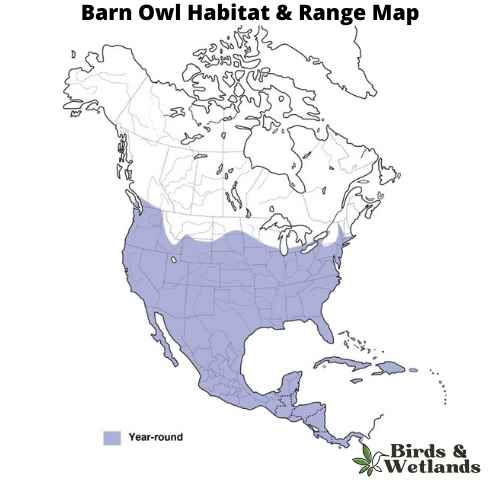
Barn Owl Sound
Scientific Name: Tyto alba
Length: 13 to 15 in
Wingspan: 31 to 37 in
Weight: 9.2 oz
The Barn Owl is a widespread species of owl known for its distinctive heart-shaped facial disc.
Barn Owls are medium-sized owls, they are pale overall with golden-brown wings and back, contrasted by a white face, chest, and belly. Their most notable feature is their heart-shaped facial disc, which helps channel sound to their ears.
Barn Owls are typically found in open habitats, including farmland, woodland, and marshes. They are named for their habit of nesting in human structures such as barns, church towers, and in the hollows of large trees. These owls are nocturnal, hunting at night and roosting during the day.
The diet of Barn Owls primarily consists of small mammals, particularly rodents such as mice and rats. They are known for their silent flight, which allows them to sneak up on their prey without detection.
Barn Owls have a unique nesting behavior. They do not build nests, but instead, lay their eggs directly on the bare surface of a secluded ledge or cavity. A female typically lays 4-7 eggs, and both parents help incubate the eggs and care for the chicks.
The long-eared owl (Asio otus)

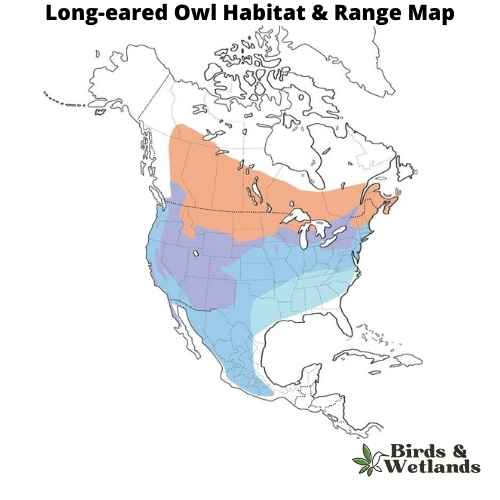
Long-eared Owl Sound
Scientific Name: Asio otus
Length: 12 and 16 in
Wingspan: 2 ft 10 in to 3 ft 4 in
Weight: 5.6 to 15.3 oz
The Long-eared Owl is a medium-sized owl species known for its distinctively long ear tufts, which can be raised or lowered depending on the bird’s mood or intention.
Long-eared Owls have mottled brown and cream plumage, which provides excellent camouflage among the trees. Their most distinctive features are their long, black-tipped ear tufts, which are set closer to the center of the head than in most other owl species.
These owls inhabit a wide variety of habitats, including deciduous and coniferous forests, woodlands, and even semi-deserts.
The Long-eared Owl’s diet primarily consists of small mammals, especially voles, but they will also take small birds and insects. They are skillful hunters, often capturing prey from a perch or in flight.
In terms of nesting behavior, Long-eared Owls do not construct their own nests, instead they take over old nests built by other bird species, usually those of corvids or other large birds. They lay an average of 4 to 5 eggs, which are incubated by the female while the male provides food.
Short-eared Owl (Asio flammeus)


Short-eared Owl Sound
Scientific Name: Asio flammeus
Length: 13–17 in
Wingspan: 33 to 43 in
Weight: 7.3–16.8 oz
The Short-eared Owl is a medium-sized owl species with a wide distribution, found across North and South America, Europe, Asia, and many Pacific islands. Despite its name, the “ears” of the Short-eared Owl are not often visible, as they are small and tend to blend with the bird’s feathers.
The owls are predominantly brown with buff and white accents throughout their body and wings, and dark patches around their yellow eyes.
Short-eared Owls diet consists largely of small mammals, especially voles. However, they are opportunistic hunters and will also prey on a variety of other animals, including other birds, when available.
Their habitat is characterized by open areas like grasslands, marshes, and tundra. They nest on the ground, which is unusual for owls, and this makes them vulnerable to ground predators. As such, they often live in areas with tall grasses or other ground cover for protection.
Northern Saw-whet Owl (Aegolius acadicus)

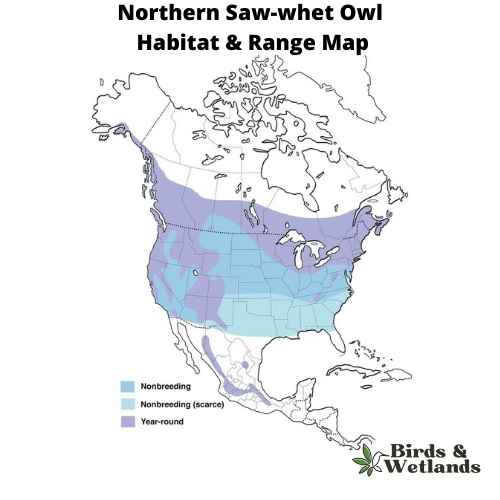
Northern Saw-whet Owl Sound
Scientific Name: Aegolius acadicus
Length: 17–22 cm (6.7–8.7 in)
Wingspan: 42–56.3 cm (16.5–22.2 in)
Weight: 54 to 151 g (1.9 to 5.3 oz)
The Northern Saw-whet Owl is a tiny, speckled gray owl and it’s one of the smallest owls in North America. It’s also known as the Little Owl or Wood Owl in some areas.
Northern Saw-whet Owls have dark brown eyes, white eyebrows, and yellow beak. It has brownish-grey feathers that are spotted with white. The owl’s legs are covered in feathers and appear nearly invisible when the bird is perched on a branch or tree.
In the winter they migrate south to warmer climates. They prefer to live in dense coniferous forest with large trees but will occasionally nest in shrubs or other vegetation that can protect them from predators.
The Northern Saw-whet Owl eats mice and voles (small rodents), small birds, frogs, salamanders, moles and shrews, but unlike most owls they chop their prey up and spread over a few meals. They will also eat insects like beetles and grasshoppers if they are available. It hunts from a perch at night using its excellent hearing to locate prey items within about 30 feet (9 meters) of its nest.
These owls nest in tree cavities usually located close to water sources such as lakes or rivers where they can find their food source (insects). They lay 2-4 eggs at one time which incubate for about 30 days before hatching.
Western Screech-Owl (Western Screech-Owl)
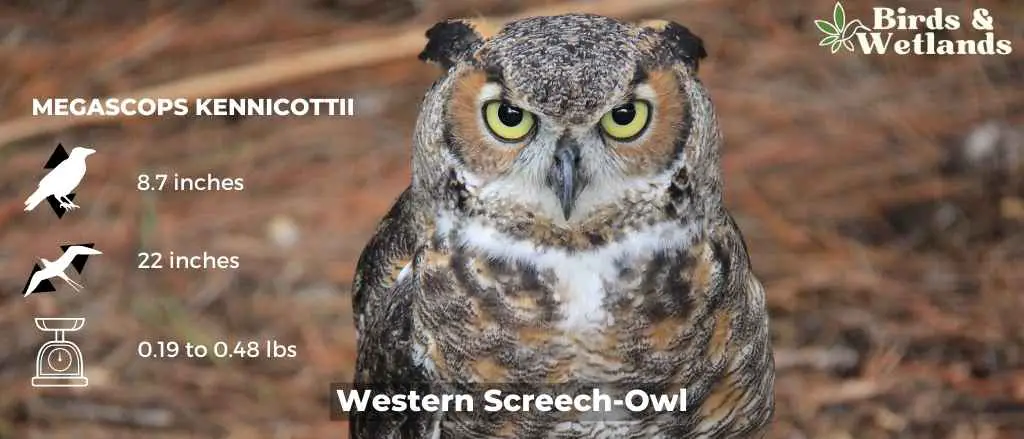

Western Screech-Owl Sound
Scientific Name: Megascops kennicottii
Length: 22 cm (8.7 in)
Wingspan: 55 cm (22 in)n
Weight: 88 to 220 g (3.1 to 7.8 oz)
The Western Screech-Owl, or Megascops kennicottii, is a small species of owl native to North and Central America. Western Screech-Owls are nocturnal predators, and its diet primarily consists of small mammals, birds, insects, and occasionally fish.
This owl is medium-sized compared to other screech-owls. It has a compact, stocky body, and is often recognized by its large head with yellow eyes surrounded by greyish-brown facial disks. The plumage is generally a mixture of grey and brown, with intricate patterns of spots and streaks that provide excellent camouflage against tree bark.
These owls prefer mixed woodland habitats, including deciduous forests and semi-open areas with trees. They often nest in tree cavities, but will also readily take to nest boxes if available. These birds are primarily non-migratory, and once they’ve established a territory, they tend to stay within the same area year-round.
Whiskered Screech-Owl (Megascops trichopsis)
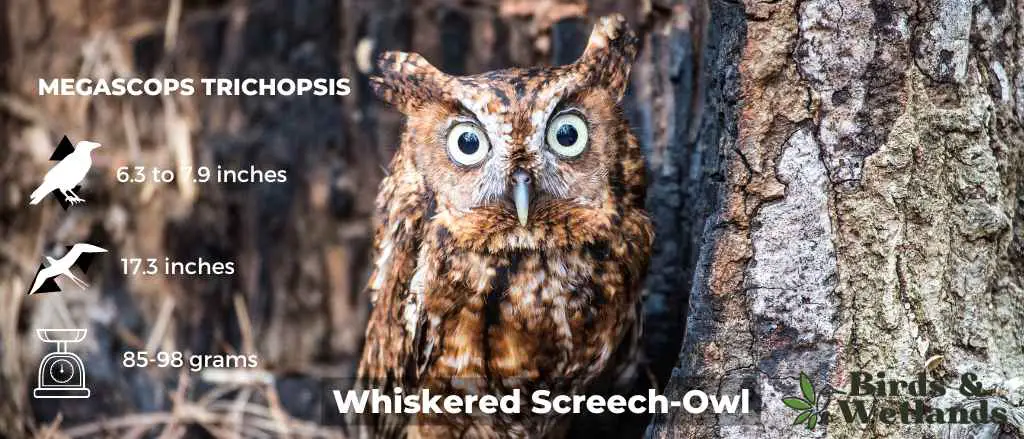
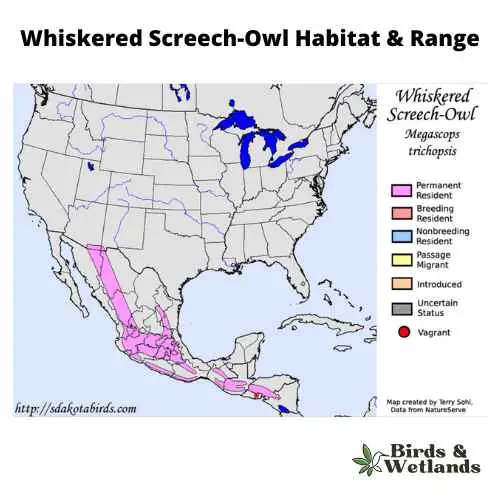
Whiskered Screech-Owl Sound
Scientific Name: Megascops trichopsis
Length: 6.3 to 7.9 in
Wingspan: 17.3 in
Weight: 85 – 98 g
The Whiskered Screech-Owl is predominantly found in pine-oak and evergreen forests in Mexico and the southwestern United States.
The Whiskered Screech-Owl presents a fascinating blend of colours; a rufous or grey hue dominates its plumage, accompanied by streaks and patterns of white on its underparts. One of the most distinctive features of this owl is the presence of “whisker” like feather tufts around its beak, which gives the species its name.
Whiskered Screech-Owls diet is primarily insectivorous, feeding on a variety of insects and spiders, but it’s also known to consume small mammals, birds, and reptiles when available.
Whiskered Screech-Owls are cavity nesters, often occupying tree holes left by woodpeckers or naturally occurring cavities in trees. They lay a clutch of 2 to 4 eggs, which are incubated by the female for about a month.
The Spotted Owl (Strix occidentalis)
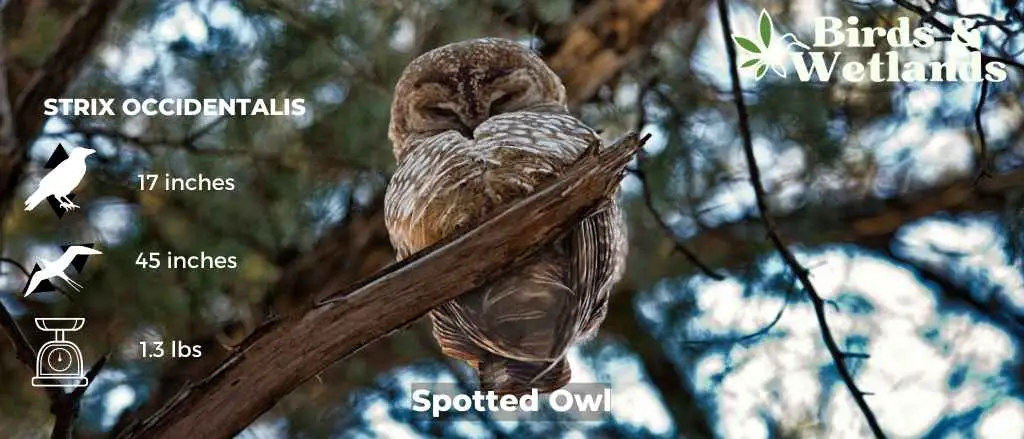
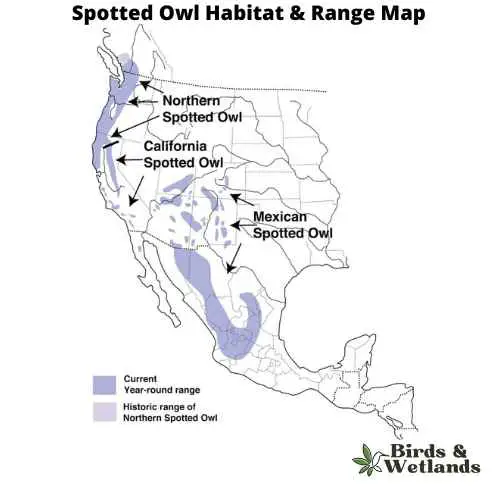
Scientific Name: Strix occidentalis
Length: 17in
Wingspan: 45 in
Weight: 1.3 lb
Spotted owls have a large head and eyes, with a small beak. Their feathers are light brown in color, with white spots on their wing feathers, and dark bars on their tail feathers. They have white spots on their upper body and wings. It has large yellow eyes and a yellow beak.
Its habitat is usually dense coniferous forests. It can be found in old-growth forests of the Pacific Northwest, where it often nests in trees at least 40 feet high.
The spotted owl feeds on small mammals such as rodents and squirrels as well as birds like quail and grouse. It hunts at night when most other animals are sleeping so that it doesn’t get caught by predators like hawks or snakes which also hunt at night time.
Spotted Owls usually nest in tree cavities created by woodpeckers or other birds who eat holes in trees where they make their nests too! The female lays three eggs at a time and both parents take turns sitting on them while they’re incubating (hatching). Once they hatch out, the parents take turns feeding them until they are old enough to hunt for themselves.
Northern Pygmy-Owl (Glaucidium gnoma)

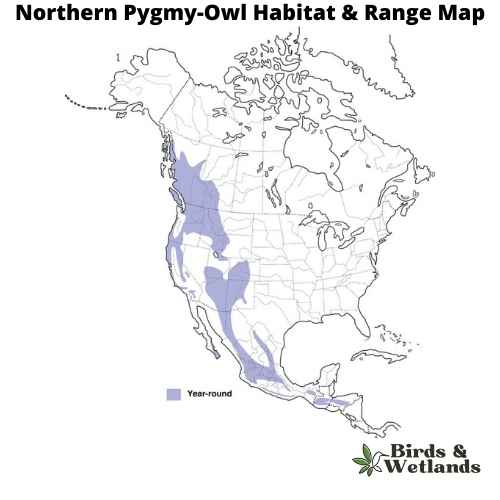
Northern Pygmy-Owl Sound
Scientific Name: Glaucidium gnoma
Length: 7 – 7 1/2 in)
Wingspan: 14.5 – 16 in
Weight: 62-73g
The Northern Pygmy-Owl is a small owl species native to North and Central America. Despite its small size, this owl is a fierce predator, known for its distinctive call and daytime hunting habits.
They have a rounded head without ear tufts and large yellow eyes. Their overall coloration is gray or brown with a pattern of white spots on the back and streaks on the front.
Northern Pygmy-Owls inhabit a range of habitats, including coniferous forests, deciduous woodlands, and mixed forests. They can be found at a range of elevations from lowlands to mountains. Unlike many other owl species, they are often active during the day, particularly in the early morning and late afternoon.
Their diet primarily consists of small mammals and birds, but they are also known to eat insects and reptiles. Despite their small size, they have been known to take prey up to three times their own size.
Northern Pygmy-Owls nest in tree cavities, often those created by woodpeckers. They do not build nests of their own but will add a few feathers to the cavity. Clutch size is usually around 2 to 7 eggs, which are incubated by the female while the male brings food.
Ferruginous Pygmy-Owl (Glaucidium brasilianum)


Ferruginous Pygmy-Owl Sound
Scientific Name: Glaucidium brasilianum
Length: 6.50 to 7.09 in
Wingspan: 14.57 to 16.14 in
Weight: 2.20 to 2.70 oz
The Ferruginous Pygmy-Owl boasts a rather distinct colouration, with its back, wings, and head exhibiting a brown to rusty hue — a characteristic that lends the bird its ‘ferruginous’, or iron-rust, name. Contrasting this, its belly is often streaked or spotted with white. The owl’s head features yellow eyes surrounded by bold, white eyebrows, creating a striking expression. The back of the owl’s head is marked with two black patches, often mistaken for eyes by predators or prey.
Ferruginous Pygmy-Owls are versatile predators, feeding on a variety of prey including insects, spiders, and small mammals. They are also known to take birds, reptiles, and amphibians.
Nest-wise, these owls often occupy old woodpecker holes or natural tree cavities, laying a clutch of 3 to 5 eggs. After hatching, the fledglings remain in the nest for about a month, but the parents continue to feed and care for them until they are ready to live independently.
The Ferruginous Pygmy-Owl’s distinctive call is a series of soft, rhythmic toots, which can be heard at all hours of the day or night, often serving as a signal of the owl’s presence in its habitat.
Flammulated Owl (Psiloscops flammeolus)
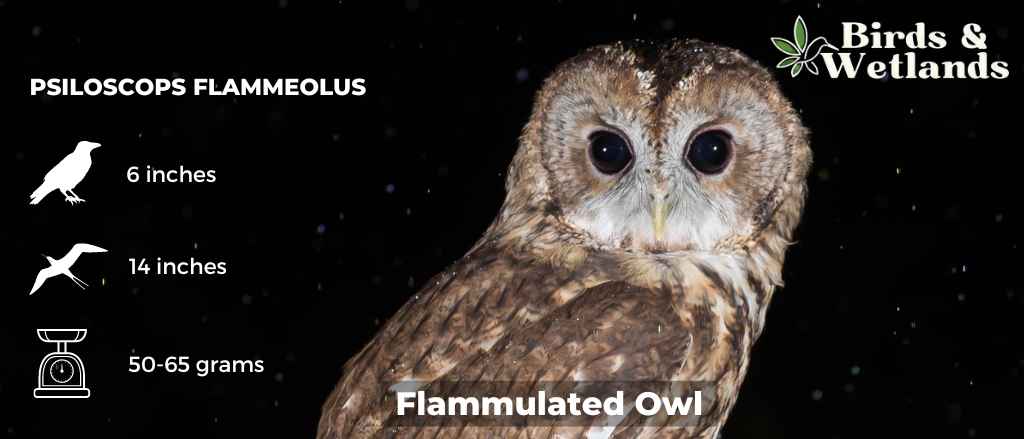
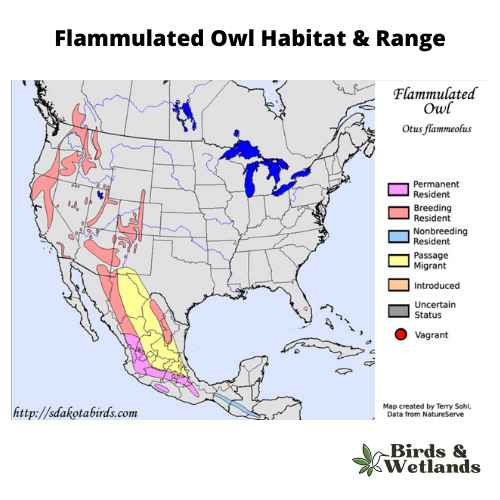
Flammulated Owl Sound
Scientific Name: Psiloscops flammeolus
Length: 6 in
Wingspan: 14 in
Weight: 1.8 – 2.3 oz
The Flammulated Owl is a small owl species native to North America, notable for its incredible migratory journeys, which may span thousands of miles.
Flammulated Owls name “flammulated” comes from the Latin word for flame, and it refers to their flame-like markings. These owls sport a mottled gray and rust color, with dark eye patches and a white throat. Their small size and cryptic plumage help them to blend into the bark of the trees in which they reside.
One of the defining traits of the Flammulated Owl is their diet they predominantly eat insects, particularly moths and beetles.
These owls prefer to nest in mature forests, often in old woodpecker holes or natural tree cavities. They typically lay 2-4 eggs, with the female incubating them for about three weeks, while the male provides food.
Flammulated Owls are known for their soft, low hooting call which can be difficult to hear. This, along with their excellent camouflage, often makes them challenging to spot, despite their widespread distribution.
Burrowing Owl (Athene cunicularia)

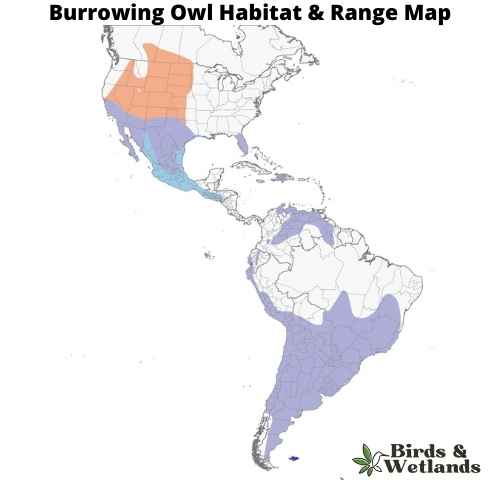
Burrowing Owl Sound
Scientific Name: Athene cunicularia
Length: 7–11 in
Wingspan: 20–24 in
Weight:5–8 oz
The Burrowing Owl is a small, long-legged species of owl found in North and South America. Known for its unusual habit of living in burrows in the ground.
Burrowing Owls have a rounded head with no ear tufts and bright yellow eyes. Their overall coloration is mottled brown and white with a distinct white “eyebrow” above each eye.
Their primary habitat includes open landscapes such as grasslands, deserts, agricultural areas, golf courses, and even airports. As their name suggests, these owls often reside in burrows, many of which are abandoned by prairie dogs, ground squirrels, or other burrowing animals. In some cases, they may also dig their own burrows.
Burrowing Owls diet consists mainly of small mammals and insects, but they also eat birds and reptiles.
Burrowing Owls have a unique nesting behavior. They lay their eggs in an underground burrow to protect them from predators and extreme weather. Clutch sizes range from 6 to 11 eggs, which are incubated for about a month before hatching.
Elf Owl


Elf Owl Sound
Scientific Name: Micrathene whitneyi
Length: 4.9 to 5.7 in
Wingspan: 10.5 in
Weight: 1.4 oz
The Elf Owl is a small species of owl that inhabits the southwestern regions of the United States and Mexico. It holds the distinction of being one of the smallest owl species in the world.
Elf Owls are tiny, they have a round head with no ear tufts, large yellow eyes, and a pale gray-brown body with a lightly spotted or streaked pattern.
The primary habitat for Elf Owls includes desert and woodland areas. They are especially fond of regions with saguaro cacti or other types of cavities in trees, which they use for nesting. They are nocturnal creatures, with most of their activity occurring after dusk.
Elf Owls feed primarily on a diet of insects and other small invertebrates. Occasionally, they may also eat small mammals and birds. They are known for their agile flight and keen hunting skills, often catching insects in midair.
When it comes to nesting, Elf Owls take advantage of the natural cavities in trees or cacti, where they lay a clutch of 2 to 4 eggs. The female is responsible for incubation, which lasts about three weeks, while the male provides food.
Where to Spot Arizona’s Owls
Petrified Forest National Park: The park’s diverse habitats, from its ancient forests to vast grasslands, make it a hotspot for various owls, including the Great Horned Owl. An evening visit offers the best chance to hear their powerful hoots echoing through the silence.
Chiricahua Mountains: Located within Coronado National Forest, these mountains are famous for their “sky islands” habitats. Here, Western Screech-owls and Whiskered Screech-owls are frequently sighted amidst the enchanting oak woodlands.
Saguaro National Park: Home to the Saguaro cactus, this park is a haven for the Elf Owl and Western Screech-owl. Dusk is the best time to spot these elusive creatures, making their nests within the giant cacti.
Sonoran Desert: The expansive scrublands of the Sonoran Desert make it an ideal dwelling for Burrowing Owls and Elf Owls. Especially in the Tucson Mountain Park, you can spot these owls peering from their burrows or cacti at twilight.
Organ Pipe Cactus National Monument: This unique lowland thornscrub habitat is one of the few places in the US where you might spot the rare Ferruginous Pygmy Owl, making it a must-visit for any serious birdwatcher.
| Neighbouring State | Main Owl Watching Site |
|---|---|
| Main Owl-Watching Site | Great Basin National Park |
| California Owls | Point Reyes National Seashore |
| New Mexico Owls | Bosque del Apache National Wildlife Refuge |
| Utah Owls | Bryce Canyon National Park |
| Colorado Owls | Rocky Mountain National Park |
Tips on How to Spot Owls in Arizona?
- Research owl species in Arizona: Familiarize yourself with the different owl species found in Arizona. Some common species of Owl include the Western Screech-Owl, Great Horned Owl, Elf Owl, Burrowing Owl, and Northern Pygmy-Owl. Knowing their appearances, habitats, and vocalizations will greatly assist in identification.
- Know the best time: Owls are primarily nocturnal, meaning they are most active during the night. However, some species may also be active at dawn and dusk. Plan your bird-watching outings accordingly, either in the early morning or late evening.
- Locate suitable habitats: Different owl species inhabit varied habitats. For example, the Great Horned Owl prefers woodlands, while the Burrowing Owl can be found in open grasslands and deserts. Research and identify the specific habitats preferred by the species you wish to spot, and visit those areas.
- Listen for calls: Owls often vocalize, especially during the breeding season. Learn the distinctive calls of the owls you’re targeting. Before your outing, listen to audio recordings or use mobile apps that provide owl calls to familiarize yourself with their vocalizations. During your bird-watching trip, pay attention to owl calls in the target habitat, as this can help you locate them.
- Look for roosting spots: During the day, owls tend to roost in trees, snags, or other concealed areas. Scan the tree branches and look for areas where owls might be hiding. Keep in mind that owls are excellent at camouflage, so a keen eye and patience are essential.
- Use binoculars: Invest in a good pair of binoculars with suitable magnification and image quality. Owls may be perched high up in trees or hidden among foliage, so binoculars will help you observe them more closely.
- Join local birding groups or clubs: Networking with experienced bird watchers can provide valuable insights into owl sightings. Attend birding field trips, workshops, or lectures organized by these groups. Sharing information with fellow birders and learning from their experiences can greatly enhance your chances of spotting owls.
- Practice ethical bird watching: Remember to respect wildlife and their habitats. Keep a safe distance from owls and avoid disturbing them. Use quiet and cautious movements to prevent causing unnecessary stress or harm.
- Seek guidance from experts: If you’re struggling to spot owls, consider contacting local birding experts, park rangers, or birding organizations in Arizona. They can offer specific advice, suggest hotspots, or even guide you on owl-watching tours.
Remember, owl spotting requires patience, persistence, and a deep appreciation for the natural world. Enjoy the process and take time to immerse yourself in the beauty of Arizona’s diverse birdlife.


